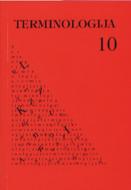Lietuvių terminografija: praeities bruožai, dabarties sunkumai ir uždaviniai
Lithuanian terminography: features of the past, difficulties of the present and tasks
Author(s): Jonas KlimavičiusSubject(s): Language and Literature Studies
Published by: Lietuvių Kalbos Institutas
Keywords: lithuanian terminography; terminographical work; Lithuanian Scientific Society; Jonas Jablonskis; principle of purity; Terminological Commission; unprofessional purism; institutionalisation; Programm of the Usage and Development of the State Language
Summary/Abstract: Lithuanian terminography can be said to have begun in 1821. The old terminography is in manuscripts, the first printed terminological dictionary appeared in 1907. For nearly one hundred years terminographical work was done by single enthusiasts, mainly botanists. The Lithuanian Scientific Society (established in 1907), stimulated by the movement of national revival, gave a stimulus to a more organised approach, but did not have enough time to offer an appreciable result. The beginning of organised terminography – discussions about creation of terms by specialists united round the Lithuanian linguist Jonas Jablonskis in the rear of the World War I, in Voronezh in Russia. The principle of purity in Jablonskis’ concept of terminology was essential. In the first Terminological Commission, which worked in the Republic of Lithuania between 1921-1926, even the teaching of Jablonskis and his authority did not stop unprofessional and unmoderate purism, which revealed itself in plentiful and inappropriate neologisms. However, the later Terminological Commission of the Lithuanian Language Society established the organised creation, discussion and approval of terminology and institutionalized it. From 1938 until 1954 there is a big gap in the work of terminography. The preparation of the first normalising dictionary of the Lithuanian language (Dabartinės lietuvių kalbos žodynas) (1954) gave a good basis for terminography. However, almost every terminological dictionary was Lithuanian-Russian and there were a lot of translation-loans from the Russian language, which in the propaganda were valued as an enrichment of the Lithuanian language. On the whole, the theoretical and methodological foundations wavered from time to time. At the end of 1971 the Terminology Council at the Presidium of the Academy of Sciences was established. It did not push terminographical works forward noticeably, but it encouraged one significant innovation – the usage of English (less frequently – of other languages) in dictionaries of terms. At the time of the second Republic of Lithuania (from 1990) the real boom of terminography happened – about 200 terminological dictionaries were published. The big inducement was the Programm of the Usage and Development of the State Language 1996-2005. Procedures for the preparation and approval of terminological dictionaries were approved. A few fundamental multilingual terminological dictionaries were published. However, the disbalance of quantity and lack of quality is noticeable. Terminographical work in Lithuania is not viewed as scientific activity. Its planing, organising and co-ordination are not institutionalized. The rise of terminographical work still remains in the future.
Journal: Terminologija
- Issue Year: 2003
- Issue No: 10
- Page Range: 9-32
- Page Count: 24
- Language: Lithuanian

